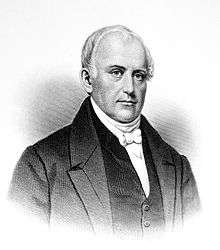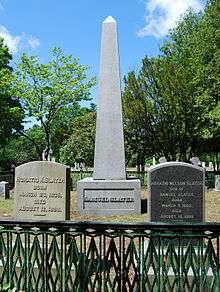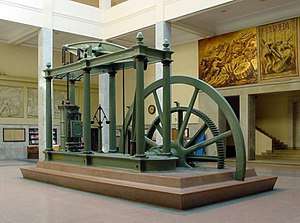Samuel Slater
Samuel Slater (June 9, 1768 – April 21, 1835) was an early English-American industrialist known as the "Father of the American Industrial Revolution" (a phrase coined by Andrew Jackson) and the "Father of the American Factory System". In the UK, he was called "Slater the Traitor"[2] because he brought British textile technology to America, modifying it for United States use. He stole the designs of textile factory machinery as an apprentice to a pioneer in the British industry before migrating to the United States at the age of 21. He designed the first textile mills in the US and later went into business for himself, developing a family business with his sons. He eventually owned thirteen spinning mills and had developed tenant farms and company towns around his textile mills, such as Slatersville, Rhode Island.
Samuel Slater | |
|---|---|
 Samuel Slater (1768–1835) popularly called "The Father of the American Industrial Revolution" | |
| Born | June 9, 1768 Belper, Derbyshire, England |
| Died | April 21, 1835 (aged 66) |
| Nationality | English |
| Occupation | Industrialist, Author |
| Known for | Bringing the Industrial Revolution to the U.S. from Great Britain |
| Net worth | USD $1.3 million at the time of his death (approximately 1/1312th of US GNP)[1] |
| Spouse(s) | Hannah Wilkinson Slater (1791 – her death, 1812); Esther Parkinson (1817 – his death) |
| Signature | |
Early life
Samuel Slater was born in Belper, Derbyshire, England, to William and Elizabeth Slater, on June 9, 1768, the fifth son of a farming family of eight children. He received a basic education, perhaps at a school run by Thomas Jackson.[2] At age ten, he began work at the cotton mill opened that year by Jedediah Strutt using the water frame pioneered by Richard Arkwright at nearby Cromford Mill. In 1782, his father died and his family indentured Samuel as an apprentice to Strutt.[3] Slater was well trained by Strutt and, by age 21, he had gained a thorough knowledge of the organization and practice of cotton spinning.
He learned of the American interest in developing similar machines, and he was also aware of British law against exporting the designs. He therefore memorized as much as he could and departed for New York in 1789. Some people of Belper called him "Slater the Traitor", as they considered his move a betrayal of the town where many earned their living at Strutt's mills.[4]
American factories
In 1789, leading Rhode Island industrialist Moses Brown moved to Pawtucket, Rhode Island to operate a mill in partnership with his son-in-law William Almy and cousin Smith Brown.[2] Almy & Brown, as the company was to be called, was housed in a former fulling mill near the Pawtucket Falls of the Blackstone River. They planned to manufacture cloth for sale, with yarn to be spun on spinning wheels, jennies, and frames, using water power. In August, they acquired a 32-spindle frame "after the Arkwright pattern", but could not operate it. At this point, Slater wrote to them offering his services ←–—°′″ Slater realized that nothing could be done with the machinery as it stood, and convinced Brown of his knowledge. He promised: "If I do not make as good yarn, as they do in England, I will have nothing for my services, but will throw the whole of what I have attempted over the bridge."[5] In 1790, he signed a contract with Brown to replicate the British designs. Their deal provided Slater the funds to build the water frames and associated machinery, with a half share in their capital value and the profits derived from them. By December, the shop was operational with ten to twelve workers. By 1791, Slater had some machinery in operation, despite shortages of tools and skilled mechanics. In 1793, Slater and Brown opened their first factory in Pawtucket.
Slater knew the secret of Arkwright's success—namely, that account had to be taken of varying fibre lengths—but he also understood Arkwright's carding, drawing, and roving machines. He also had the experience of working with all the elements as a continuous production system. During construction, Slater made some adjustments to the designs to fit local needs. The result was the first successful water-powered roller spinning textile mill in America.
After developing this mill, Slater instituted principles of management which he had learned from Strutt and Arkwright to teach workers to be skilled mechanics.
In 1812, Slater built the Old Green Mill, later known as Cranston Print Works, in East Village in Webster, Massachusetts. He moved to Webster due in part to an available workforce, but also due to abundant water power from Webster Lake.[6]
Management style
Slater created the "Rhode Island System", factory practices based upon the patterns of family life in New England villages. Children aged 7 to 12 were the first employees of the mill; Slater personally supervised them closely. The first child workers were hired in 1790.[7] From his experience in Milford, it is highly unlikely that Slater resorted to physical punishment of the children, relying instead on a system of fines. Slater tried to recruit workers from other villages, but that fell through due to the close-knit framework of the New England family.
He brought in whole families, developing entire villages.[8] He provided company-owned housing nearby, along with company stores; he sponsored a Sunday School where college students taught the children reading and writing.
Expansion
Slater constructed a new mill in 1793 for the sole purpose of textile manufacture under the name Almy, Brown & Slater, as he was now partners with Almy and Brown. It was a 72-spindle mill; the patenting of Eli Whitney's cotton gin in 1794 reduced the labor in processing cotton. It also enabled profitable cultivation of short-staple cotton, which could be grown in the interior uplands, resulting in a dramatic expansion of cotton cultivation throughout the Deep South in the antebellum years. The New England mills and their labor force of free men depended on southern cotton, which was based on slave labor. Slater also brought the Sunday School system from his native England to his textile factory at Pawtucket.
In 1798, Samuel Slater split from Almy and Brown, forming Samuel Slater & Company in partnership with his father-in-law Oziel Wilkinson. They developed other mills in Rhode Island, Massachusetts, Connecticut, and New Hampshire.[9]
In 1799, he was joined by his brother John Slater from England. John was a wheelwright who had spent time studying the latest English developments and might well have gained experience of the spinning mule.[2] Samuel put John Slater in charge of a large mill which he called the White Mill.[10]
By 1810, Slater held part ownership in three factories in Massachusetts and Rhode Island. In 1823, he bought a mill in Connecticut. He also built factories to make the textile manufacturing machinery used by many of the region's mills, and formed a partnership with his brother-in-law to produce iron for use in machinery construction. But Slater spread himself too thin, and was unable to coordinate or integrate his many different business interests. He refused to go outside his family to hire managers and, after 1829, he made his sons partners in the new umbrella firm of Samuel Slater and Sons. His son Horatio Nelson Slater completely reorganized the family business, introduced cost-cutting measures and giving up old-fashioned procedures. Slater & Company became one of the leading manufacturing companies in the United States. Due to the oppressive rules and working conditions and a proposed cut of 25% in the wages of women workers by Slater and the other Mill Owners near Pawtuckett, in 1824 this area was the site of the first factory strike in US history. Thus beginning the long struggle for human rights between factory workers and owners, which is still continuing today. https://www.newenglandhistoricalsociety.com/1824-factory-strike-1824/
Slater also hired recruiters to search for families willing to work at the mill. He advertised to attract more families for the mills.
Industrialization

By 1800, the success of the Slater mill had been duplicated by other entrepreneurs. By 1810, Secretary of the Treasury Albert Gallatin reported that the U.S. had some 50 cotton-yarn mills, many of them started in response to the Embargo of 1807 that cut off imports from Britain prior to the War of 1812. That war resulted in speeding up the process of industrialization in New England. By war's end in 1815, there were 140 cotton manufacturers within 30 miles of Providence, employing 26,000 hands and operating 130,000 spindles. The American textile industry was launched.
Personal life
In 1791, Slater married Hannah Wilkinson; she invented two-ply thread, becoming in 1793 the first American woman to be granted a patent.[11] Samuel and Hannah had 10 children together, although four died during infancy. Hannah died in 1812 from complications of childbirth, leaving Samuel with six young children to raise.[12] Along with his brother, Samuel started the Slater family in America.
Slater married for a second time in 1817, to a widow, Esther Parkinson. As his business was extremely successful by this time, and as Parkinson also owned property prior to their marriage, the couple had a pre-nuptial agreement prepared.[12]
Slater died on April 21, 1835, in Webster, Massachusetts, a town which he had founded in 1832 and named for his friend Senator Daniel Webster. At the time of his death, he owned 13 mills and was worth USD $1.3 million, the equivalent in 2018 of USD $35 million.
Legacy and honors
Slater's original mill still stands, known today as Slater Mill and listed on the National Register of Historic Places. It is operated as a museum dedicated to preserving the history of Samuel Slater and his contribution to American industry. Slater's original mill in Pawtucket and the town of Slatersville are both part of the Blackstone River Valley National Historical Park, which was created to preserve and interpret the history of the industrial development of the region.
In 2018 the Samuel Slater Restaurant named in his honor opened at the Indian Ranch campground located on the shore of Webster Lake in Webster Massachusetts.
His papers are held at the Harvard Business School's Baker Library.[13]
References
Notes
- Klepper, Michael; Gunther, Michael (1996), The Wealthy 100: From Benjamin Franklin to Bill Gates—A Ranking of the Richest Americans, Past and Present, Secaucus, New Jersey: Carol Publishing Group, p. xiii, ISBN 978-0-8065-1800-8, OCLC 33818143
- Everett et al. (Slater Study Group) (2006) "Samuel Slater - Hero or Traitor?" Milford, Derbyshire: Maypole Promotions
- A possible cause of confusion may be that some old British textbooks record that Slater was at New Mills in Cheshire, now in Derbyshire. His indentures, however, are in the possession of the Arkwright Society and clearly record his being apprenticed at "New Mills in the Parish of Duffield" – present day Milford, Derbyshire
- "Samuel Slater: American hero or British traitor?", BBC, 22 September 2011.
- White, G.S., (1836) Memoir of Samuel Slater, Philadelphia: reprinted Augustus M. Kelly, 1967 in Everett et al. (Slater Study Group)
- Early History of Webster, Dudley, and Oxford, by Paul J. Macek & James R. Morrison
- "Samuel Slater and Moses Brown Change America" Archived 2009-05-27 at the Wayback Machine
- No. 384: Samuel Slater
- Tucker (1984)
- Tucker (2008), p. 102
- "History Detectives: Women inventors". PBS.
- Newell, Aimee (2013). A Stitch in Time: The Needlework of Aging Women in Antebellum America. Ohio University Press. p. 120.
- Linard, Laura; Sverdloff, Brent M. (Winter 1997). "Not Just Business as Usual: Evolving Trends in Historical Research at Baker Library". The American Archivist. 60 (1): 88–98. JSTOR 40294027.
Bibliography
- Cameron, Edward H. Samuel Slater, Father of American Manufactures (1960) scholarly biography
- Conrad, Jr., James L. "'Drive That Branch': Samuel Slater, the Power Loom, and the Writing of America's Textile History", Technology and Culture, Vol. 36, No. 1 (Jan., 1995), pp. 1–28 in JSTOR
- Everett et al. (Slater Study Group) (2006) "Samuel Slater - Hero or Traitor?" Milford, Derbyshire: Maypole Promotions. Formative years in Derbyshire.
- Tucker, Barbara M. "The Merchant, the Manufacturer, and the Factory Manager: The Case of Samuel Slater", Business History Review, Vol. 55, No. 3 (Autumn, 1981), pp. 297–313 in JSTOR
- Tucker, Barbara M. Samuel Slater and the Origins of the American Textile Industry, 1790-1860 (1984)
- Tucker, Barbara M. and Kenneth H. Tucker. Industrializing Antebellum America: The Rise of Manufacturing Entrepreneurs in the Early Republic (2008)
- White, George S. Memoir of Samuel Slater: The Father of American Manufactures (1836, repr. 1967)
External links
| Wikisource has the text of a 1911 Encyclopædia Britannica article about Samuel Slater. |
- Slater Mill website
- Slater Mill, Sarah Leavitt, Arcadia Publishing, 1997 ISBN 978-0-7524-0567-4
- VIDEO "Samuel Slater - Hero or Traitor?" (2006) Maypole Promotions
- Slater family business records at Baker Library Special Collections, Harvard Business School
